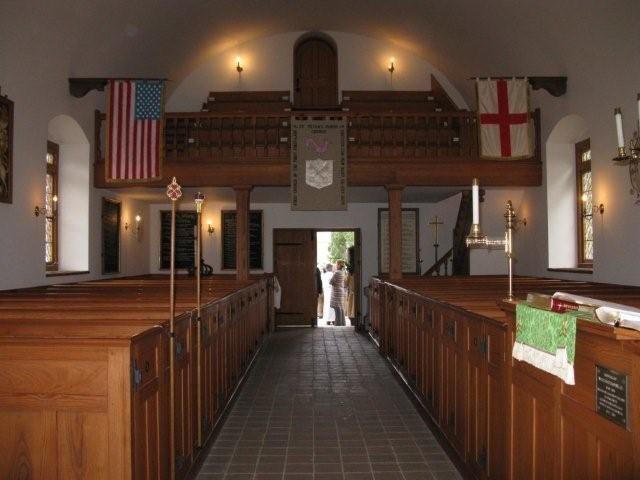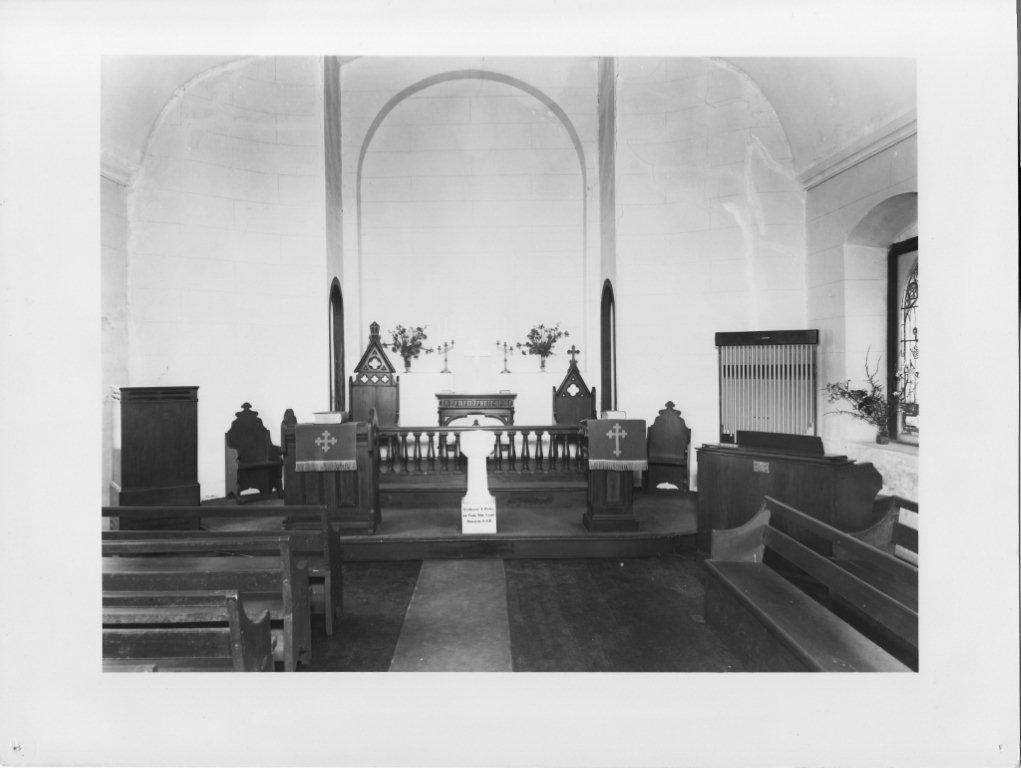Church Interior

Author: Steve Avent
Everyone who enters St. Peter’s Church for the first time seems to be struck by the simple beauty and serenity of its interior. This has not come about by accident, as much thought, work and research has gone into making St. Peter’s as authentic to its 17th century roots as possible. Most of the restoration of the church took place at two periods, 1951-52, and 1964, with the 1964 restoration requiring the interior to be completely gutted, and rebuilt from the ground up. The restoration process was guided by several sources: the vestry book of the parish, which covers the period from 1684-1758, and so covers the period of construction of the church itself (1701-1703) and the tower (ca. 1740); physical remnants of the original construction process, discovered when the church was gutted in 1964; other 17th century structures in the area, including "Criss Cross", in New Kent, and Bel Air plantation, in Charles City County; and 17th century structures still standing in Kent, England, where the church’s builder and designer, William Hughes, originated.
Not much is known about the church’s original interior arrangement. The pulpit, then as now, was placed on the north side, with the male members of the congregation on that side of the building, and the females on the other. There was a central aisle, paved with brick. The east wall of the church was wainscoted (paneled) up to the bottom of the east window. The pews were constructed of "native pine".
Here is a picture of the Church interior taken around 1959, prior to the restoration in 1964.

Much of what I’m about to relate is probably known by many of the parishioners of St. Peter’s, but for the benefit of the relative newcomers, let’s take a tour of the interior of the church. The west door to the church is modeled after the door of "Criss Cross" .
As you enter the church from the west, you first encounter the "Christening Pew" on the right (south) side. This pew, like the pews used by the choir and the organist, is a "box pew" (seats on all four sides) while all the others in the church are "slip pews". The large, octagonal stone font is decorated with symbols of Christian baptism; with the date of the church’s construction; with the initials of George and Martha Washington and of David Mossom, the parish rector who officiated at the Washington marriage in 1759; of Henry Compton, the Bishop of London who was important in the early history of the Anglican Church in Virginia; of William A. Brown, late Bishop of Southern Virginia who took a great interest in the restoration of St. Peter’s; and of Samuel Blackwell Chilton, late Suffragen Bishop of Virginia who was rector of St. Peter’s Parish from 1928 to 1938, leading the 20th century rebirth of the old parish. Since the 13th century or earlier, the traditional place for the font has been near the west or principal entrance, symbolizing entrance into the church through baptism. The font has a soakaway, so that the consecrated water can drain directly to the earth.
To your left is the "Table of Kindred and Affinity", which decrees which family members may be married to other family members. This was written by an Archbishop Parker in 1563, based on the 18th chapter of Liviticus, and was required by the Canons of 1604. Its principles are still a part of the Canon Law of the Episcopal Church. There is also a marble font against the west wall, inscribed "St. Peter’s Church in New Kent County, given by E.A.D". This font was given to the church by Rev. Edwin A. Dalrymple, who was hired as rector of St. Peter’s parish in 1843, and preached the first sermon when the church was reopened after the War Between the States, November 10, 1872.
Proceeding eastward, the flag to your left with the red cross on a white background is the flag of England, symbolizing our connection to the Anglican Church. (This flag was combined with the flags of Scotland, Wales and Ireland to create the Union Jack). Over your head to your right is the American flag. On the north wall you see a drawing of a cherub – this is a "Scriptural-Sentence", and is modeled after a 1711 example by a William Mackreth, at Hawkshead, Lancashire, England. The Royal Arms of Queen Anne (1702-1707) are on the south wall across from the Scripture-Sentences.
On the east wall are painted boards containing the Apostle’s Creed, the Lord’s Prayer and the Ten Commandments, also required by the 1604 Canons. In the east, on the north and south walls, are two wall monuments, and are two of the most interesting architectural features of the church. One is a monument to Parson Mossom, believed buried beneath the chancel of the church, and the other is to William Chamberlayne, who is believed to have introduced George and Martha Washington. There are thirteen known surviving church wall monuments in the entire United States: three in Massachusetts, two each in Pennsylvania and South Carolina, one in Maryland, one in North Carolina, and four in Virginia. Two of the Virginia monuments are in Bruton Parish Church, and the other two are here in St. Peter’s. The Chamberlayne monument is signed by sculptor Michael Sidnell ("M. Sidnell Bristol Fecit" – made by Michael Sidnell in Bristol, England). This is believed to be the oldest signed wall monument in America.
There are two significant differences between the appearance of the present church and the 18th century St. Peter’s. The first is the existence of the altar rail. It is most likely that this was not present in the original church, as it was more common to have the communion carried out to the congregation in the pews. The design of the altar rail is authentic, however, and is based on a stair rail at "Bel Air" , a 17th century plantation in Charles City County. The second is that there was likely a "chancel screen" in the original church. A "chancel screen" separated the area around the altar from the rest of the church and was a fairly common feature of medieval churches and cathedrals. During the 1964 restoration the ends of a large beam at the proper height were found about 12 feet from the east wall, thus placing the screen in the aisle, about midway down the choir and organist pews.



